The Dairy Farm NCERT Solutions | Mathematics (Maths Mela) Class 5 - New NCERT PDF Download
| Table of contents |

|
| Page No. 70-71 |

|
| Page No. 72-74 |

|
| Page No. 75-76 |

|
| Page No. 77-78 |

|
| Page No. 79-80 |

|
| Page No. 83-84 |

|
| Page No. 85 |

|
| Page No. 86-90 |

|
| Page No. 91 |

|
Page No. 70-71
Let Us Think
Q1: The given shapes stand for numbers between 1 and 24. The same shape denotes the same number across all problems. Find the numbers hiding in all the shapes.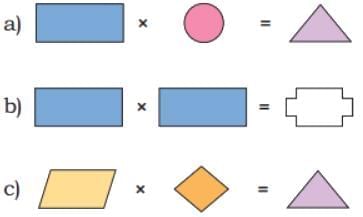
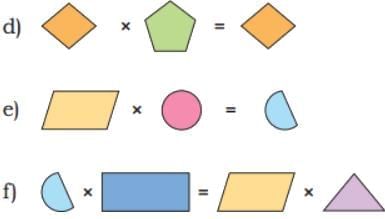
Ans:
This can be solved by using trial and error method.
Here, the one set of possible values of shapes are as follows:
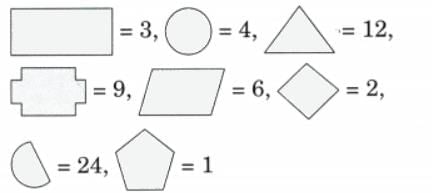
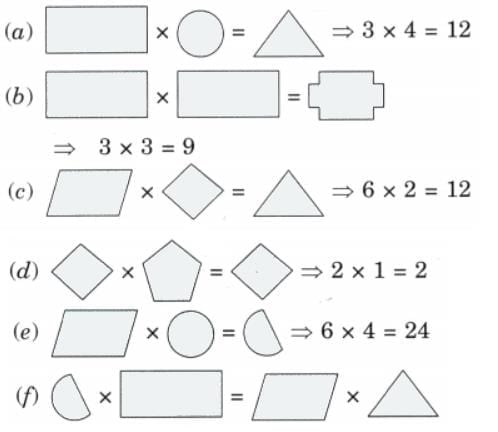
⇒ 24 × 3 = 6 × 12 = 72
Q2: Place the digits 2, 5, and 3 appropriately to get a product close to 100. Share your reasoning in class.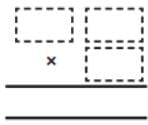
Ans:
If we round off the product obtained, that is, 106 to the nearest 10 we get 110 which is closer to 100 than the other products that can be obtained using the given digits in the question.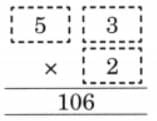
Q3: A dairy has packed butter milk pouches in the following manner. Find the number of pouches kept in each arrangement. One is done for you.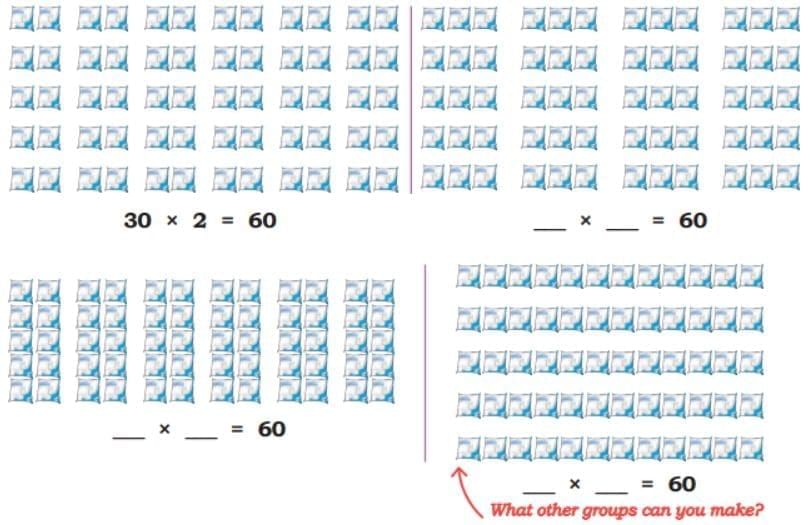
Ans: 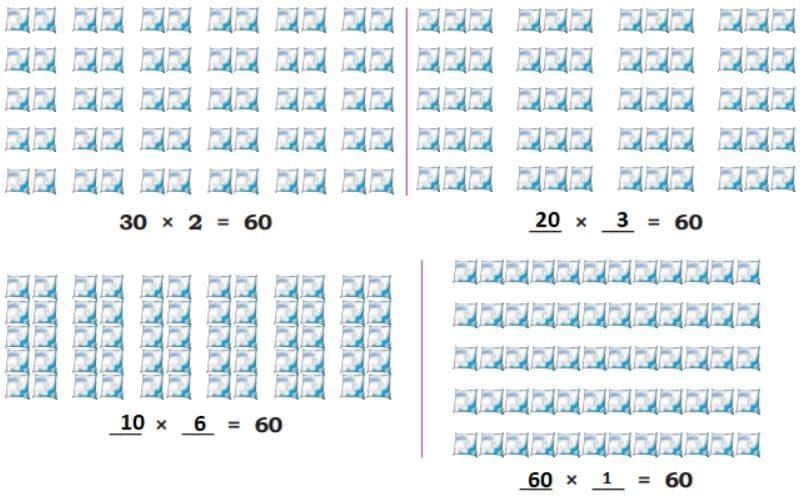
Q4: Which number am I?
I am a two-digit number, help of the following clues.
(а) I am greater than 8.
(b) I am not a multiple of 4.
(c) I am a multiple of 9.
(d) I am an odd number.
(e) I am not a multiple of 11.
(f) I am less than 50.
(g) My ones digit is even.
(h) My tens digit is odd.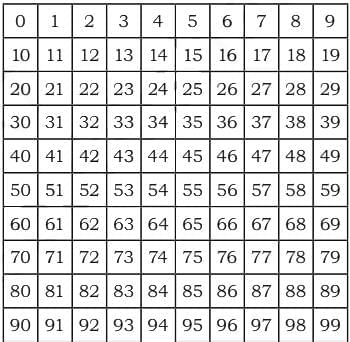
Ans:
Step 1: All 2-digit multiples of 9 less than 50 are: 18, 27, 36, 45
Step 2: Remove multiples of 4. 36 is a multiple of 4. So, remove it.
Remaining number are: 18, 27, 45
Step 3: Keep only odd numbers. Since, 18 is even. So, remove it.
Then the remaining numbers are: 27 and 45.
Step 4: Remove multiples of 11: 22, 33, 44, 55,… Here, neither 27 nor 45 is a multiple of 11. So, both the numbers remain.
Step 5: But the numbers are less than 50 So, both 27 and 45 are fit with the given clue.
Step 6: Ones digit is even. But, in 27, ones digit is 7 (odd) and in 45, ones digit is 5 (odd).
Here, is a contradiction. As both the numbers 27 and 45 are odd. [as per the clue (d)].
Hence, no 2-digit number is possible that satisfies all the given clues.
Q:  Ans:
Ans:
Except clue (a) and (b), rest of all the clues were helpful in trying to guess the number.
If we ignore clue (d), the number should be either 18 or 36.
And if we ignore clues (g) and (h), and consider clues (e) then the number should be either 27 or 45.
Q5: Make your own numbers.
Choose any two numbers and one operation from the grid. Try to make all the numbers between 0 and 20. For example 2 can be formed as 4 – 2. Could you make all the numbers?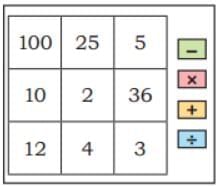
Ans:
36 – 25 =11, (Answer may vary) or 36 ÷ 4 = 9, etc.
Q: Which numbers could you not make? Is it possible to make these numbers using three numbers? You can use two operations, if needed. Which numbers between 0-20 can you get in more than one way?
Ans:
Do it yourself.
Page No. 72-74
Order of Numbers in Multiplication
Q: Daljeet Kaur runs a milk processing unit. She has arranged the butter packets in the following ways. Find the number of butter packets in each case. What pattern do you notice (or observe)? Discuss in class.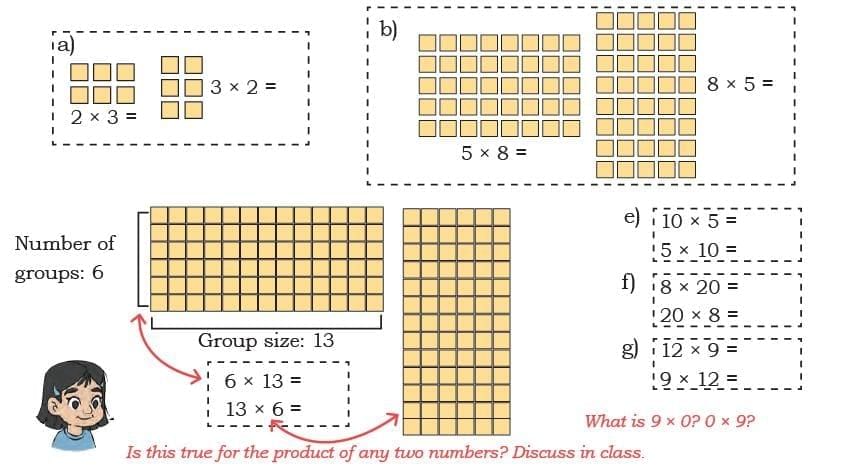
Ans: 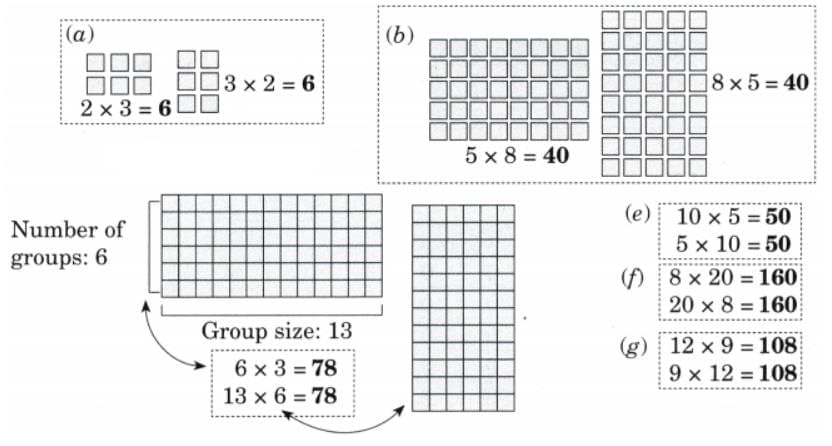
What is 9 × 0? 0 × 9?
Ans:
9 × 0 = 0 and 0 × 9 = 0
Is this true for the product of any two numbers. Discuss in class.
Ans:
The number of groups and the group size are interchanged in each case above, but the total number of butter packets remain the same.
Patterns in Multiplication by 10s and 100s
Q1: Let us revise multiplication by 10s and 100s.
(a) 4 × 10 = _____
(b) 20 × 10 = _____
(c) 10 × 40 = _____
(d) 10 × 10 = 100
(e) 20 × 50 = ______
(f) 80 × 10 = ______
(g) 3 × 100 = 100 × 3 = 300
(h) 8 × 100 = _____ = ______
(i) 10 × 100 = _____ = ______
Ans:
(a) 4 × 10 = 40
(b) 20 × 10 = 200
(c) 10 × 40 = 400
(d) 10 × 10 = 100
(e) 20 × 50 = 1000
(f) 80 × 10 = 800
(g) 3 × 100 = 100 × 3 = 300
(h) 8 × 100 = 100 × 8 = 800
(j) 10 × 100 = 100 × 10 = 1000
Q2: Find the answers to the following questions. Fill in the table below and describe the pattern. Discuss in class. Ans:
Ans:
(100 × 90 = 9,000)
(400 × 10 = 4.000)
(60 × 50 = 3.000)
(30 × 20 = 600)
(700 × 4 = 2,800)
(10 × 45 = 450)
Q: How should we write 450 in the table below?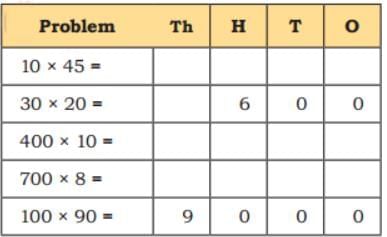 Ans:
Ans: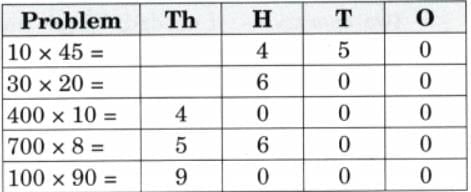
Q: 
Ans: 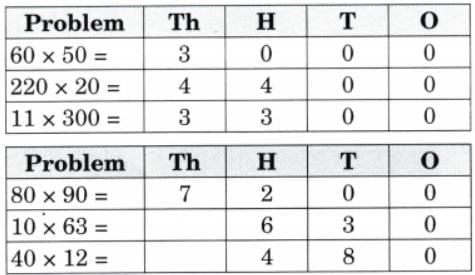
Q: Let us fill in the table and observe the patterns.
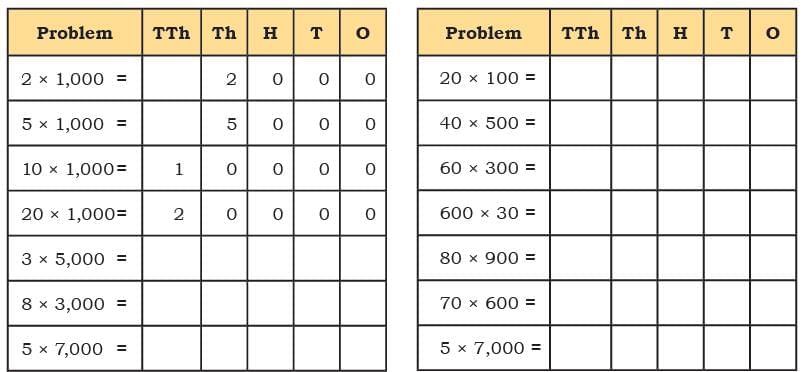
Ans: 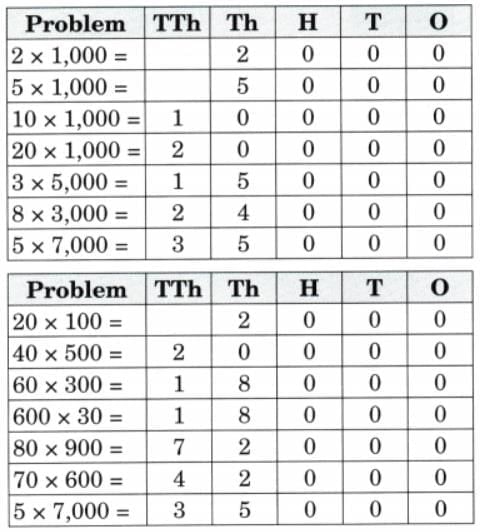
Page No. 75-76
Doubling and Halving
Q: Butter packets are arranged in the following ways. Let us find some strategies to calculate the total number of packets.
(a) 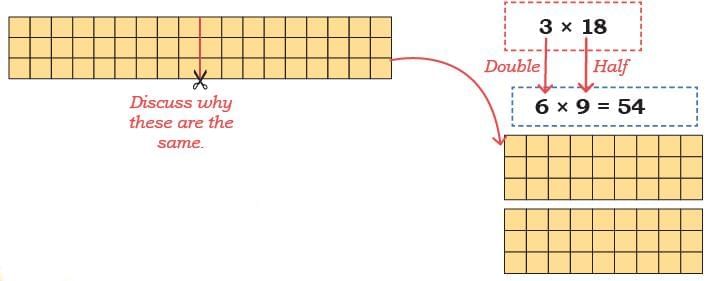
(b) 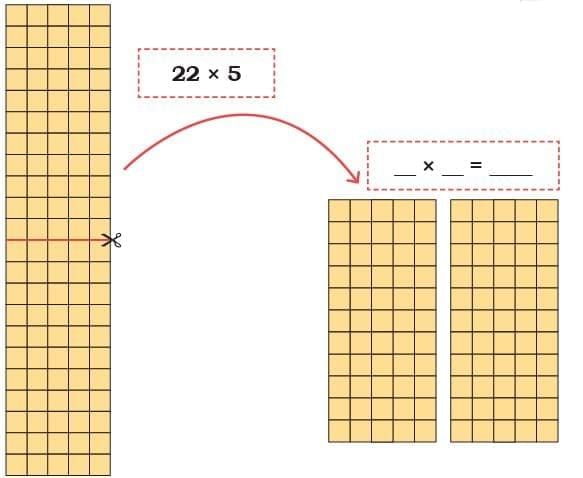
(c) Solve the following problems like the previous ones.
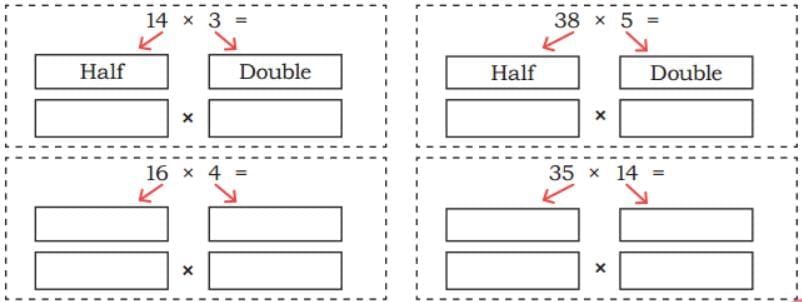 Ans:
Ans: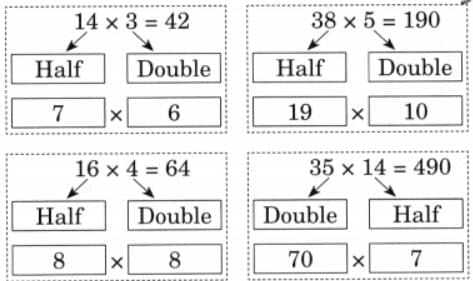 Q: This halving and doubling strategy works well when we have to multiply with numbers like 5 and 25. Discuss why?
Q: This halving and doubling strategy works well when we have to multiply with numbers like 5 and 25. Discuss why?
Ans:
No, for such numbers like 5 and 25, we need to change our strategy, as we cannot half those numbers, as they are odd and can make the calculation even complicated.
(d) Find the product by halving and doubling either the multiplier or the multiplicand.
(1) 5 × 18
(2) 50 × 28
(3) 15 × 22
(4) 25 × 12
(5) 12 × 45
(6) 16 × 45
Ans: 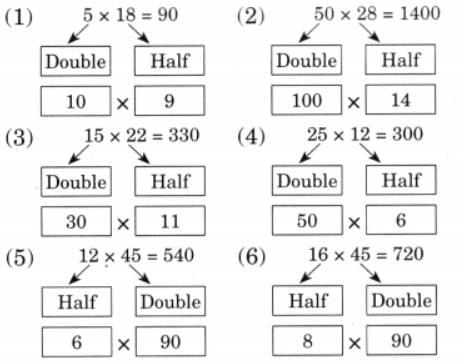
(e) Give 5 examples of multiplication problems where halving and doubling will help in finding the product easily. Find the products as well.
Ans: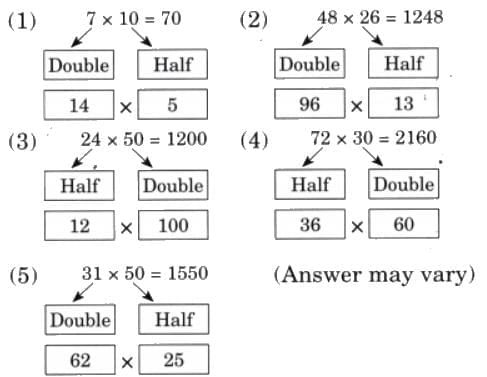
Nearest Multiple
(a) 4 × 19
(b) 14 × 21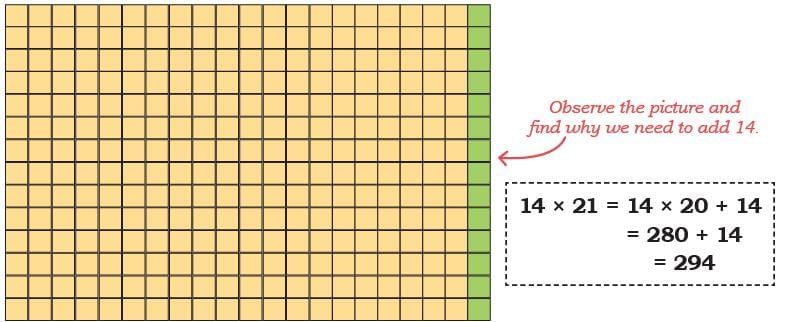
(c) Give 5 examples of problems where you can use the nearest multiple to find the product easily. Find the products as well.
Ans:
(1) 5 × 31 = 5 × 30 + 5 = 150 + 5 = 155
(2) 7 × 29 = 7 × 30 – 7 = 210 – 7 = 203
(3) 12 × 49 = 12 × 50 – 12 = 600 – 12 = 588
(4) 8 × 101 = 8 × 100 + 8 = 800 + 8 = 808
(5) 16 × 99 = 16 × 100 – 16 = 1600 – 16 = 1584
(Answer may vary)
(d) Find the products of the following numbers by finding the nearest multiple.
(1) 7 × 52
(2) 12 × 28
(3) 75 × 31
(4) 99 × 15
(5) 8 × 25
(6) 22 × 42
Ans:
(1) 7 × 52 = 7 × 50 + 7 × 2 = 350 + 14 = 364
(2) 12 × 28 = 12 × 30 – 12 × 2 = 360 – 24 = 336
(3) 75 × 31 = 75 × 30 + 75 = 2250 + 75 = 2325
(4) 99 × 15 = 100 × 15 – 15 = 1500 – 15 = 1485
(5) 8 × 25 = 10 × 25 – 2 × 25 = 250 – 50 = 200
(6) 22 × 42 = 22 × 40 + 22 × 2 = 880 + 44 = 924
Page No. 77-78
Let Us Solve
Use strategies flexibly to answer the following questions. Discuss you thoughts in class.
Q1: A school has an auditorium with 35 rows, with 42 seats in each row. How many people can sit in this auditorium?
Ans:
Number of rows = 35
Number of seats in each row = 42
Total number of seats in all = 35 × 42 = 35 × 40 + 35 × 2
= 1400 + 70
= 1470
Thus, 1470 people can sit in the auditorium.
Q2: Priya jogs 4 kilometres every day. How many kilometres will she jog in 31 days?
Ans:
Priya jogs everyday = 4 km
Number of kilometres she will jog in 31 days = 4 × 31 = 4 × 30 + 4 = 120 + 4 = 124 km
Thus, Priya will jogs 124 km in 31 days.
Q3: A school has received 36 boxes of books with 48 books in each box. How many total books did the school receive in the boxes?
Ans:
Number of books in each box = 48
Number of boxes received by the schools 36
Total number of book received by the school = 36 × 48 = 36 × 50 – 36 × 2
= 1800 – 72
= 1728 books
Thus, the school received 1728 books in all.
Q4: Priya uses 16 metres of cloth to make 4 kurtas. How much cloth would she need to make 8 kurtas?
Ans:
Cloth used to make 4 kurtas = 16 metres
Kurta 1 Kurta 2 Kurta 3 Kurta 4 4 metres + 4 metres + 4 metres + 4 metres
Since, cloth used in 1 Kurta = 4 metres So, required length of the cloth for 8 kurtas = 4 × 8 = 4 × 10 – 4 × 2 = 40 – 8 = 32
Thus, Priya needs 32 metre of cloth to make 8 kurtas.
Q5: Gollappa has 29 cows on his farm. Each cow produces 5 litres of milk per day. How many litres of milk do the cow produce in total, each day?
Ans:
Number of cows on Gollappa’s farm = 29
Milk produced by each cow = 5 litres
Total quantity of milk produced in his farm = 5 × 29 = 5 × 30 – 5 = 150 – 5 = 145 litres
Thus, 145 litres of milk is produced each day.
Q6: Maska Cow Farm has 297 cows. Each cow requires 18 kg of fodder per day. How much total fodder is needed to feed 297 cows every day?
Ans:
Total number of cows in the Maska’s farm = 297
Fodder required by each cow = 18 kg per day
Total amount of fodder required to 297 cows = 18 × 297 = 18 × 300 – 18 × 3 = 5400 – 54
= 5346 kg
Thus, 5346 kg of fodder will be required for 297 cows every day.
Page No. 79-80
Let Us Multiply
(a) 32 × 8
Ans:

(b) 69 × 45

Ans:

Let Us Do
Q: Solve the following problems like Nida did.
(a) 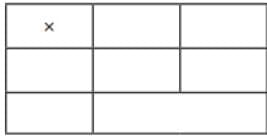
Ans: 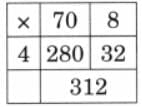
(b) 83 × 9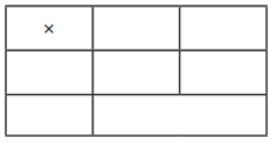
Ans:
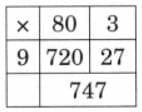
(c) 67 × 28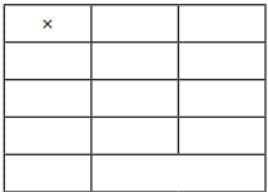
Ans: 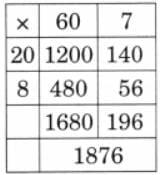
(d) 53 × 37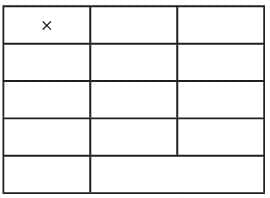
Ans: 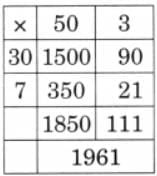
Q2: Solve the following problems like Kanti did.
(a) 94 × 5
Ans: 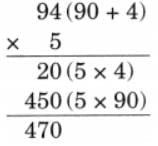
(b) 49 × 6
Ans: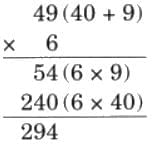
(c) 37 × 53
Ans: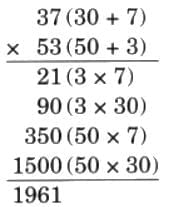
(d) 28 × 79
Ans: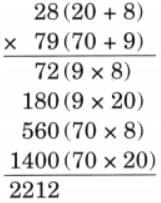
Q3: Solve the following problems like John.
(a) 86 × 3
Ans:
(b) 72 × 7
Ans:
(c) 94 × 36
Ans: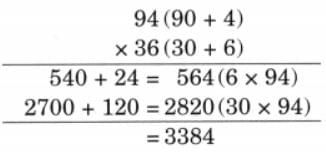
(d) 66 × 22
Ans: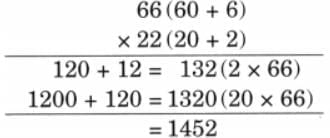
Q4: Solve the following problems:
(a) A movie theatre has 8 rows of seats, and each row has 12 seats. If half the seats are filled, how many people are watching the movie? If 3 more rows get filled, how many total people will be there?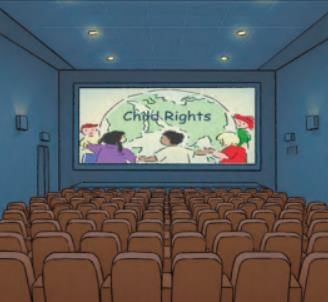 Ans:
Ans:
Number of rows of seats in the movie theatre = 8
Number of seats in each row = 12
Since, half seats are filled, that is 4 rows out of 8 are filled.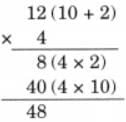
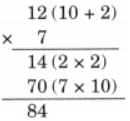
So, number of people who watched the movie = 4 × 12
Thus, 48 people watched the movie.
Now, 3 more rows get filled.
Therefore, number of people who will watch the movie = 7 × 12
Thus, 84 people will be there, if 3 more rows get filled.
(b) In a test match between India and West Indies, the Indian team hit twenty- four 4s and eighteen 6s across the two innings. How many runs were scored in 4s and 6s each? 234 runs were made by running between the wickets. If 23 runs were extras, how many runs were scored by Indian team in the two innings?
Ans:
In the test match, number of 4s hit by Indian team = 24
Therefore, runs scored by Indian team by hitting 4s = 24 × 4 = 96 runs 96 runs
In the test match, number of 6s hit by Indian team = 18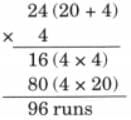
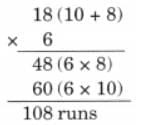
Therefore, runs scored by Indian team by hitting 6s = 18 × 6 = 108 runs
Runs scored by running between the wickets = 234 runs
Runs scored by extras = 23 runs
Therefore, total runs scored by the Indian team in two innings = 96 + 108 + 234 + 23 = 461 runs
(c) Anjali buys 15 bulbs and 12 tube lights from Sudha Electricals. Each bulb costs ?25 and each tube light costs ?34. How much money should Anjali give to the shopkeeper?
Ans:
Cost of 15 bulbs = 15 × ₹ 25 = ₹ 375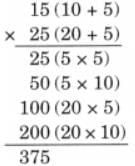
Cost of 15 bulbs = 12 × ₹ 34 = ₹ 408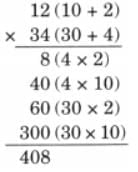
Total cost of 15 bulbs and 12 tube lights = ₹ 375 + ₹ 408 = ₹ 783
Thus, Anjali will give ₹ 783 to the shopkeeper to buy 15 bulbs and 12 tube lights.
(d) A shopkeeper sold 28 bags of rice. Each bag costs ?350. How much money did he earn by selling rice bags?
Ans:
The cost of each rice bag = ₹ 350
Since, a shopkeeper sold 28 bags of rice. 350 (300 + 50 + 0)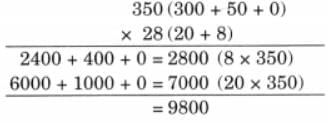
Therefore, total cost of 28 bags of rice = 350 × 28 = ₹ 9800
Thus, the shopkeeper earned ₹ 9800 by selling 28 bags of rice.
(e) A school library has 86 shelves and each shelf has 162 books. Find the number of books in the library.
Ans:
Number of shelves in the library = 86
Number of books in each shelf = 162 162(100 + 60 + 2)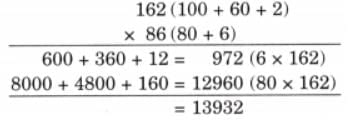
Therefore, the total number of books in the library = 162 × 86 = 13932
Page No. 83-84
Let Us Do
Q1: Solve the following problems like Nida did.
a) 548 × 6
Ans: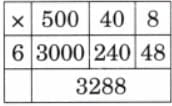
b) 682 × 3
Ans: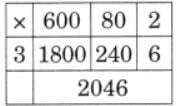
(c) 324 × 18
Ans: 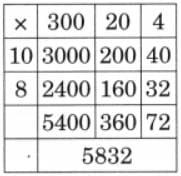
(d) 507 × 23
Ans: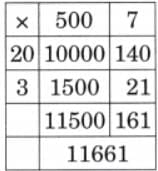
(e) 190 × 65
Ans: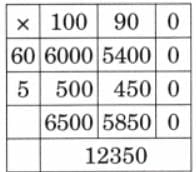
Q2: Solve the following problems like John.
(a) 123 × 84
Ans: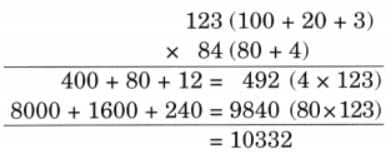
(b) 368 × 32
Ans: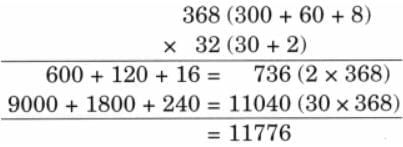
(c) 159 × 324
Ans:
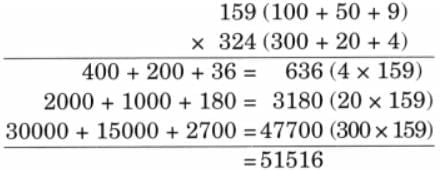
(d) 239 × 401
Ans:

(e) 592 × 5
Ans:
(f) 101 × 22
Ans: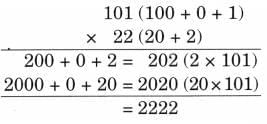
Q3: Let us solve a few questions like Mill’s father.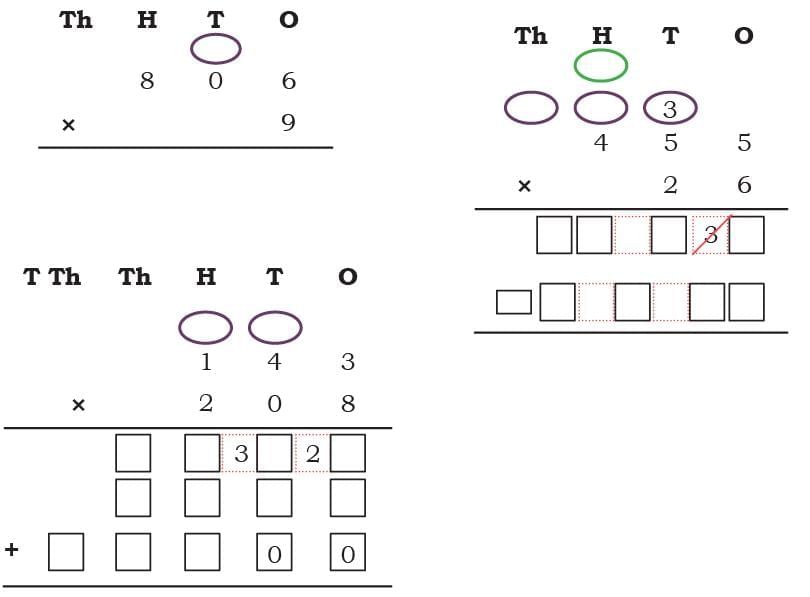 Ans:
Ans: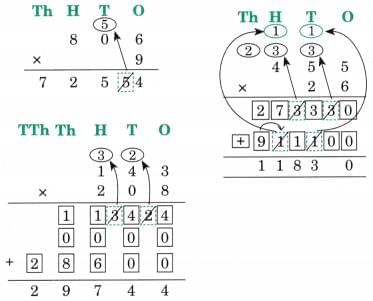
Now use Mili’s father’s method to solve the following questions.
(a) 807 × 5
Ans:
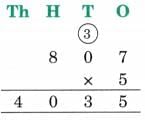
(b) 143 × 28
Ans: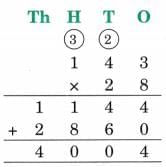
(c) 309 × 9
Ans: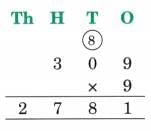
(d) 450 × 38
Ans: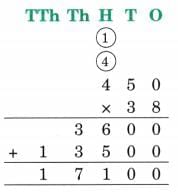
(e) 584 × 23
Ans: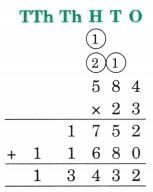
(f) 302 × 13
Ans: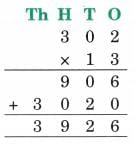
(g) 604 × 54
Ans: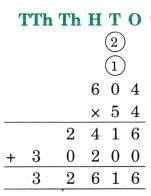
(h) 112 × 23
Ans: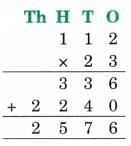
(i) 237 × 19
Ans: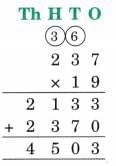
Page No. 85
Check, Check!
Check if the following children’s solutions are correct. If correct, explain why the solution is correct. If it is incorrect, then identify the error and correct the solution.
(a) Asma’s solutions for 46 × 59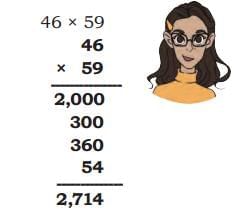
Ans:
Asma broke the multiplication into parts as follows:
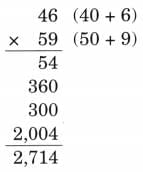
Thus, her solution is correct but the order of partial product is opposite.
(b) Pankaj’s solution for 203 × 54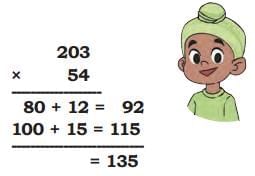
Ans:
Pankaj’s solution for 203 × 54:
Pankaj instead of200 in the partial product, he uses 20 in each steps and instead of 50, he uses 5. So, his final product is incorrect.
Correct method: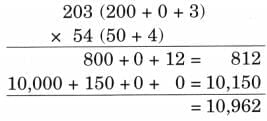
(c) Lado’s solution for 38 × 150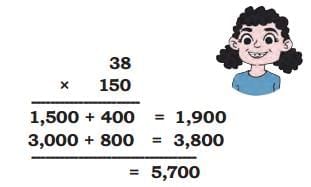
Ans:
She likely split 38 as 30 + 8 and 150 as 100 + 50
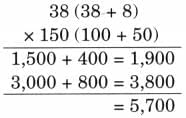
Thus, her solution is correct.
(d) Kira’s solution for 193 × 272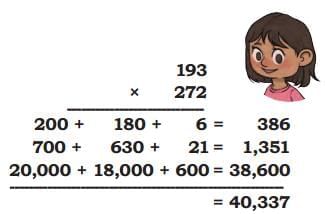
Ans:
Kira broke the first number correctly, but in second number, she use 7 instead of 70 in the partial product. So her product is incorrect. The correct method is
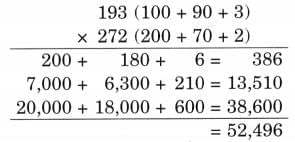
(e) Asher’s solution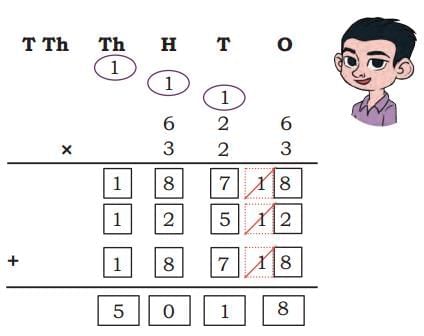
Ans:
Asher made the error in identifying the place values of 3 and 2 in 323.
The correct solution is:
626 × 323 = 2,02,198
Page No. 86-90
Let Us Do
Q1: Identify the problems that have the same answer as the one given at the top of each box. Do not calculate.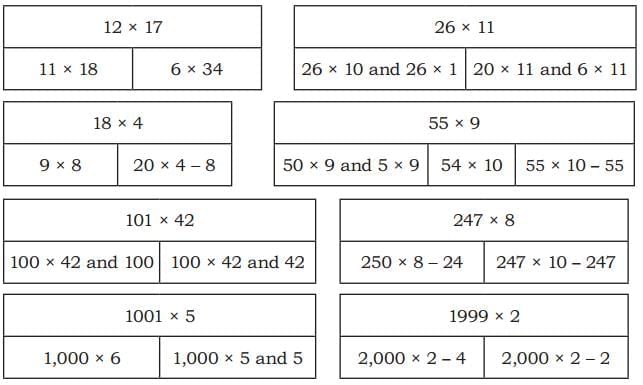 Ans:
Ans: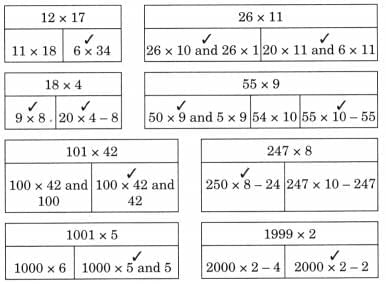
Q2: Find easy ways of solving these problems.
(a) 16 × 25
Ans:
(b) 12 × 125
Ans:
(c) 24 × 250
Ans:
(d) 36 × 25
Ans:
(e) 28 × 75
Ans:
28 × 75 = 30 × 75 – 150
= 2250 – 150
= 2100
(f) 300 × 15
Ans:
300 × 15 = 4500
(g) 50 × 78
Ans:
(h) 199 × 63
Ans:
199 × 63 = 200 × 63 – 63
= 12600 – 63
= 12537
(i) 128 × 35
Ans:
128 × 35 = 130 × 35 – 70
= 4550 – 70
= 4480
Q3: Write 5 other examples for which you can find easy ways of getting products.
Ans:
(a) 201 × 19
= 200 × 19 + 19
= 3800 + 19
= 3819
(b) 149 × 25
= 150 × 25 – 25
= 3750 – 25
= 3725
(c) 25 × 78
(d) 28 × 18
= 30 × 18 – 18 × 2
= 540 – 36
= 504
(e) 998 × 4
= 1000 × 4 – 8
= 4000 – 8
= 3992
(Answer may vary)
Q4: Find the answers to the following questions based on the given information.
(a) 17 × 23 = 391
(b) 17 × 24 = _______
(c) 17 × 22 = _______
(d) 16 × 23 = _______
(e) 8 × 9 = 72
(f) 18 × 9 = _______
(g) 28 × 9 = _______
(h) 108 × 9 = _______
(i) 18 × 23 = _______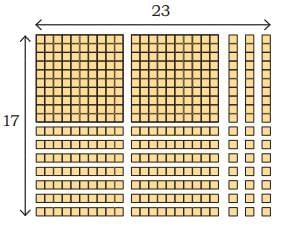
Ans:
(a) 17 × 23 = 391
(b) 17 × 24 = 408
(c) 17 × 22 = 374
(d) 16 × 23 = 368
(e) 8 × 9 = 72
(f) 18 × 9 = 162
(g) 28 × 9 = 252
(h) 108 × 9 = 972
To find 17 × 24, how much is to be added to 17 × 23 _____ 17 or 23?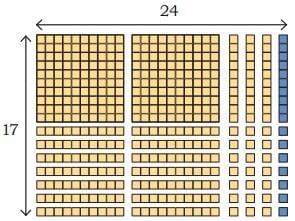
Ans:
17 × 24 = 17 × 23 + (17) = 391 + (17)
To find 18 × 23, how much is to be added to 17 × 23 _____ 17 or 23?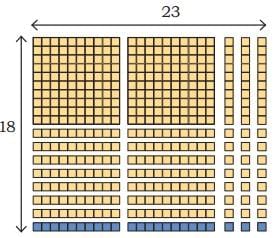 Ans:
Ans:
18 × 23 = 17 × 23 + (23)
= 391 + (23)
= 414
Let Us Think
Q1: Find the possible values of the coloured boxes in each of the following problems. The same colour indicates the same number in a problem. Some problems can have more than one answer.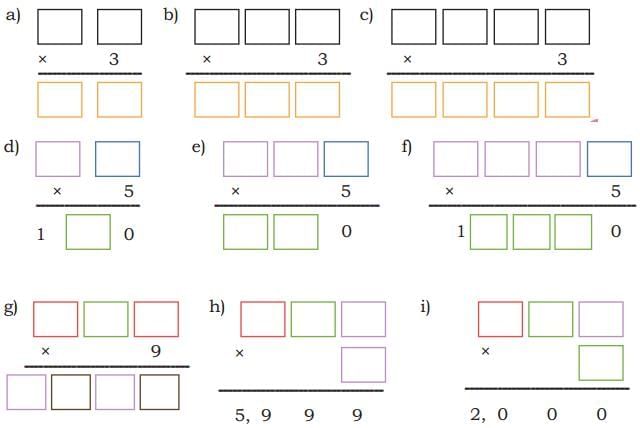
Ans:
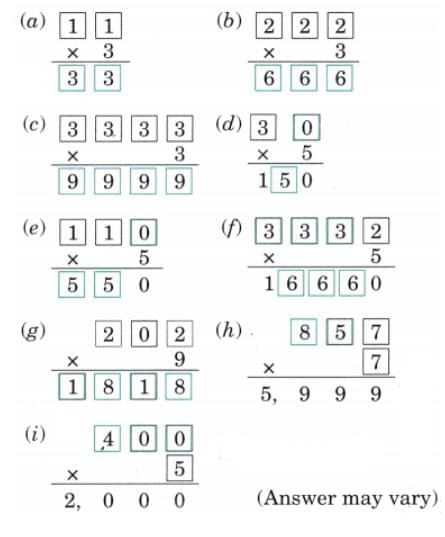
Q2: Estimate the products on the left and match them to the numbers given on the right.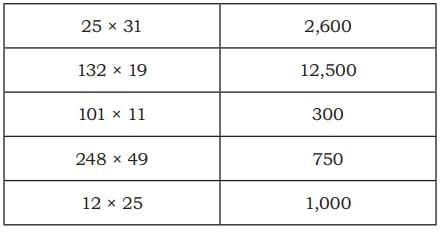
Ans:
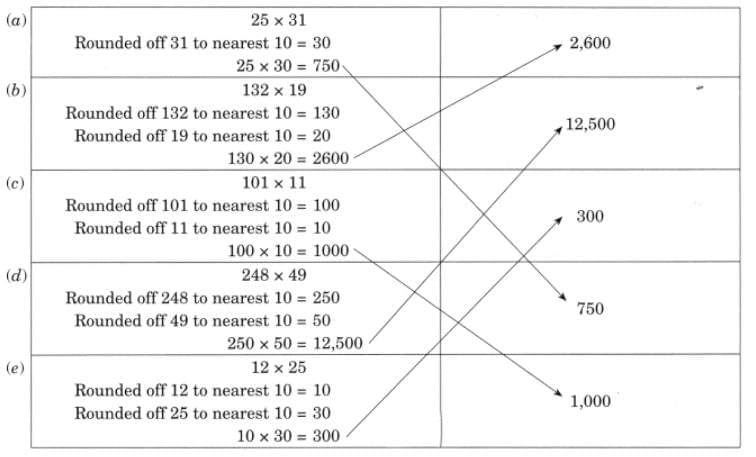
The King’s Reward
One day, a king decided to reward three of his most talented ministers. The king called them to his court and said, “You all have served my empire with great dedication. As a reward, I give you three choices of gold.
Which of the rewards would you have chosen?
Ans:
Do it yourself.
After a week, the 3 ministers were surprised at the final amount of gold coins. Guess who received the most gold coins? Calculate how much gold
Ans:
Minister-1
5 × 1 = 5 → Day 1
5 × 2 = 10 → Day 2
10 × 2 = 20 → Day 3
20 × 2 = 40 → Day 4
40 × 2 = 80 → Day 5
80 × 2 = 160 → Day 6
160 × 2 = 320 → Day 7
Minister-2
3 × 1 = 3 → Day 1
3 × 3 = 9 → Day 2
9 × 3 = 27 → Day 3
27 × 3 = 851 → Day 4
81 × 3 = 243 → Day 5
243 × 3 = 729 → Day 6
729 × 3 = 2187 → Day 7
Minister-3
1 × 1 = 1 → Day 1
1 × 5 = 5 → Day 2
5 × 5 = 25 → Day 3
25 × 5 = 125 → Day 4
125 × 5 = 625 → Day 5
625 × 5 = 3125 → Day 6
3125 × 5 = 15625 → Day 7
Minister 1 received 320 gold coins, minister 2 received 2187 coins and minister 3 received 15625 coins.
Hence, minister 3 received most number of gold coins.
Multiplication Patterns
Q1: Notice how the multiplier, multiplicand, and products are changing in each of the following. What is the relationship of the new product with the original product?- Solve (a) completely, and then predict the answers for the rest.
(a) 16 × 44 = 704
(1) 8 × 88 = 704
(2) 8 × 22 = 176
(3) 16 × 22 = ______
(4) 32 × 44 = ______
Ans:
(a) 16 × 44 = 704
(1) 8 × 88 = 704
(2) 8 × 22 = 176
(3) 16 × 22 = 352
(4) 32 × 44 = 1408
b) 12 × 32 = 384
(1) 6 × 16 = ______
(2) 24 × 16 = ______
(3) 24 × 64 = ______
(4) 12 × 16 = ______
Ans:
12 × 32 = 384
(1) 6 × 16 = 96
(2) 24 × 16 = 384
(3) 24 × 64 = 1536
(4) 12 × 16 = 192
Q2: Observe and complete the given patterns.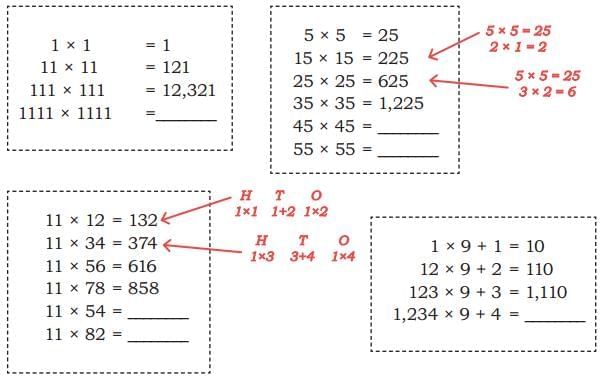 Ans:
Ans: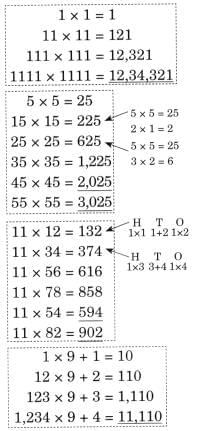
Here are some numbers.
Remember number pairs from Grade 4? Any two adjacent numbers in a row or a column are number pairs. Can you identify the pair whose product is the smallest and another pair whose product is the largest? Do you need to find every product or can you find this by looking at the numbers?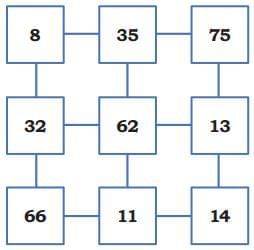 Ans:
Ans:
Do it yourself.
Page No. 91
Let Us Solve
Q1: Mala went to a book exhibition and bought 18 books. The shop was selling 3 books for ₹ 150. After buying the books, she still had ₹ 20 left. How much money did Mala have at the beginning?
Ans:
The number of books bought by the Mala = 18
Since, the cost of 3 books is ₹ 150.
Therefore, ₹ 50 + ₹ 50 + ₹50
1 book 1 book 1 book
So, the cost of 1 book = ₹ 50
Therefore, the total cost of 18 books
= 18 × 50 = 20 × 50 – 100 ,
= 1000 – 100 = 900
So, the cost of 18 books = ₹ 900
Since, Mala still had ₹ 20 left.
Therefore, Mala had ₹ 920 (₹ 900 + ₹ 20) at the beginning.
Q2: A village sports club organises a women’s football tournament. The club earned money by selling match tickets and charging fees for team participation.
They sold 57 tickets for ₹ 115 each.
They had 3 teams joining the tournament, with each team paying a participation fee of ₹ 1,599.
The teams paid ₹ 1,750 in total rent the football ground and ₹ 1,129 for food and water.
(a) How much money did the club collect in total from ticket sales and team participation fees?
(b) What were the total expenses on renting the ground and food and water?
Ans:
Money collected by selling tickets
= ₹ (57 × 115) = ₹ (60 × 115 – 3 × 115) = ₹ (6900 – 345) = ₹ 6555
Deposit of participation fees by the 3 teams = ₹ (3 × 1599) = ₹ (3 × 1600 – 3)
= ₹ 4797
Rent paid for football ground by the teams in total = m50
Cost of food and water for the teams = ₹ 1129
(a) The total money collected by the club from the tickets sales and team participation fees
= ₹ 6555 + ₹ 4797 = ₹ 11,352
(b) Total expenses on renting the ground and food and water = ₹ 1750 + ₹ 1129
= ₹ 2879
Q3: Ananya is watching Republic Day celebrations on city’s public ground. There are 12 rows of students sitting in front of her and 17 rows behind her. There are 18 students to her right and 22 students to her left.
(a) How many rows of students are there in total?
(b) How many students are there in Ananya’s row?
(c) What is the total number of students on the ground?
Ans:
(a) Number of rows of students in the ground
= 12 + 1 + 17 = 30 rows
(b) Number of students in Ananya’s row
= 18 + 1 + 22 = 41 students
(c) Total number of students on the ground
= 30 × 41 = 1230
Q4: Multiply.
(a) 67 × 78
(b) 34 × 56
(c) 45 × 263
(d) 86 × 542
(e) 432 × 107
(f) 310 × 120
Ans:
(a) 67 × 78 = 67 × 80 – 2 × 67
= 5360 – 134
= 5226
(b) 34 × 56 = 30 × 56 + 4 × 56
= 1680 + 224
= 1904
(c) 45 × 263 = 40 × 263 + 5 × 263
= 10,520 + 1315
= 11,835
(d) 86 × 542 = 86 × (540 + 2)
= 86 × 540 + 2 × 86
= 46,440 + 172
= 46,612
(e) 432 × 107 = 432 × 100 + 432 × 7
= 43,200 + 3024
= 46,224
(f) 310 × 120 = 300 × 120 + 10 × 120
= 36,000 + 1200
= 37,200
Q5: If 67 × 67 = 4489, without multiplication find 67 × 68.
Ans:
Since, 67 × 67 = 4489
∴ 67 × 68
= 67 × 67 + 67
= 4489 + 67 = 4556
Q6: If 99 × 100 = 9900, without multiplication find 99 × 99.
Ans:
Since, 99 × 100 = 9900
∴ 99 × 99
= 99 × 100 – 99
= 9900 – 99
= 9801
|
35 videos|322 docs|7 tests
|
FAQs on The Dairy Farm NCERT Solutions - Mathematics (Maths Mela) Class 5 - New NCERT
| 1. What are the main activities involved in a dairy farm? |  |
| 2. What types of cows are commonly raised on dairy farms? |  |
| 3. How is milk processed after being collected from cows? |  |
| 4. What are the nutritional benefits of milk? |  |
| 5. What are some challenges faced by dairy farmers? |  |




















